The sixth of June marked six years since Marcelo Gallardo became the coach of River Plate. Over this time with the club, he brought to the collection 11 trophies, including two Copa Libertadores titles and three Recopa Sudamericana. However, in his long spell with River Plate, the only major trophy that he didn’t manage to win is Superliga title. It was especially tough at the end of this season, where Los millonarios lost out on the long-awaited title by just one point in the last game to their great rivals Boca Juniors.
With the growing talks over Gallardo’s future and the attracted interest from such European clubs as Barcelona and some English Premier League teams, the 2019 season can be the last season of Gallardo’s long tenure with River Plate. The forced break from football around the globe halted the upcoming Superliga season for an undefined period, and this gives a chance to take a look why River Plate is the best team in the league with observing Gallardo’s tactics in this tactical analysis.
Movement in the build-up phase
Marcelo Gallardo is known for his love of using 4-1-3-2 formation, and he did not change his principles last season as well. This scheme offers many opportunities for the Argentinian to fulfil his principles in possession.
I think the main reason that Gallardo deploys this formation is the full-back — wide midfielder rotations. Overall, the roles of players in the River Plate system are flexible, and it especially applies to the aforementioned positions. The likes of Casco and Montiel can comfortably tuck in and take midfield positions, while the wide midfielders in De La Cruz and Fernández will go wide. Alternatively, the midfielders can stay put while full-backs push up wide. This dynamic is illustrated in the graphic below, where the two centre-backs, usually Martinez and Pinola, push up to the halfway line, Enzo Pérez in the holding midfield role stays with them and helps distribute the ball, and most importantly the full-backs can stay near the touchline and then wide midfielders operate in half-space.
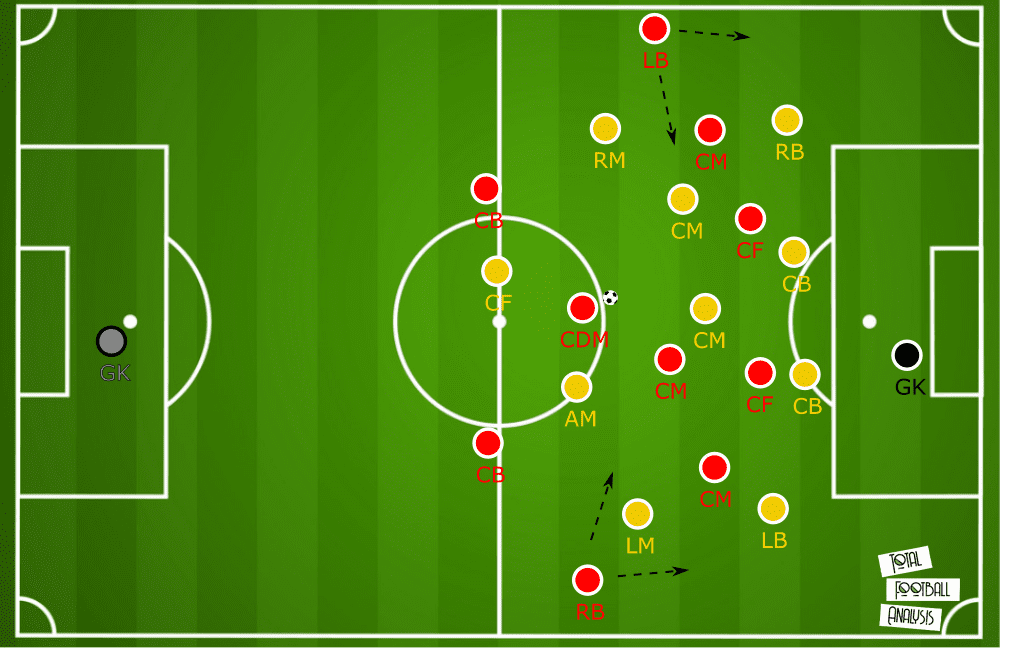
These positional rotations, along with some other ones which I will cover later in the analysis, make it hard for the opposition to track all these movements and react accordingly. It’s practically impossible to switch properly in these situations so that there are no wide-open passing lanes, and if the defenders are man-marking River Plate players then the following dragging out of position opens up huge spaces for attackers to exploit. River Plate recorded the highest xG tally in the competition with 45,5 expected goals, compared to the second-placed Boca Juniors with 33,59, so this fluidity in attack becomes the key component of creating chances for the Gallardo’s side.
In the shot below you can see an in-game example of this rotation, with Casco operating in the half-space, while De La Cruz stays wide. The ability of the latter to take on opponents with his dribbling makes his coach think about the ways of isolating him in 1v1 situations, and occasionally putting him out wide is the best variant.
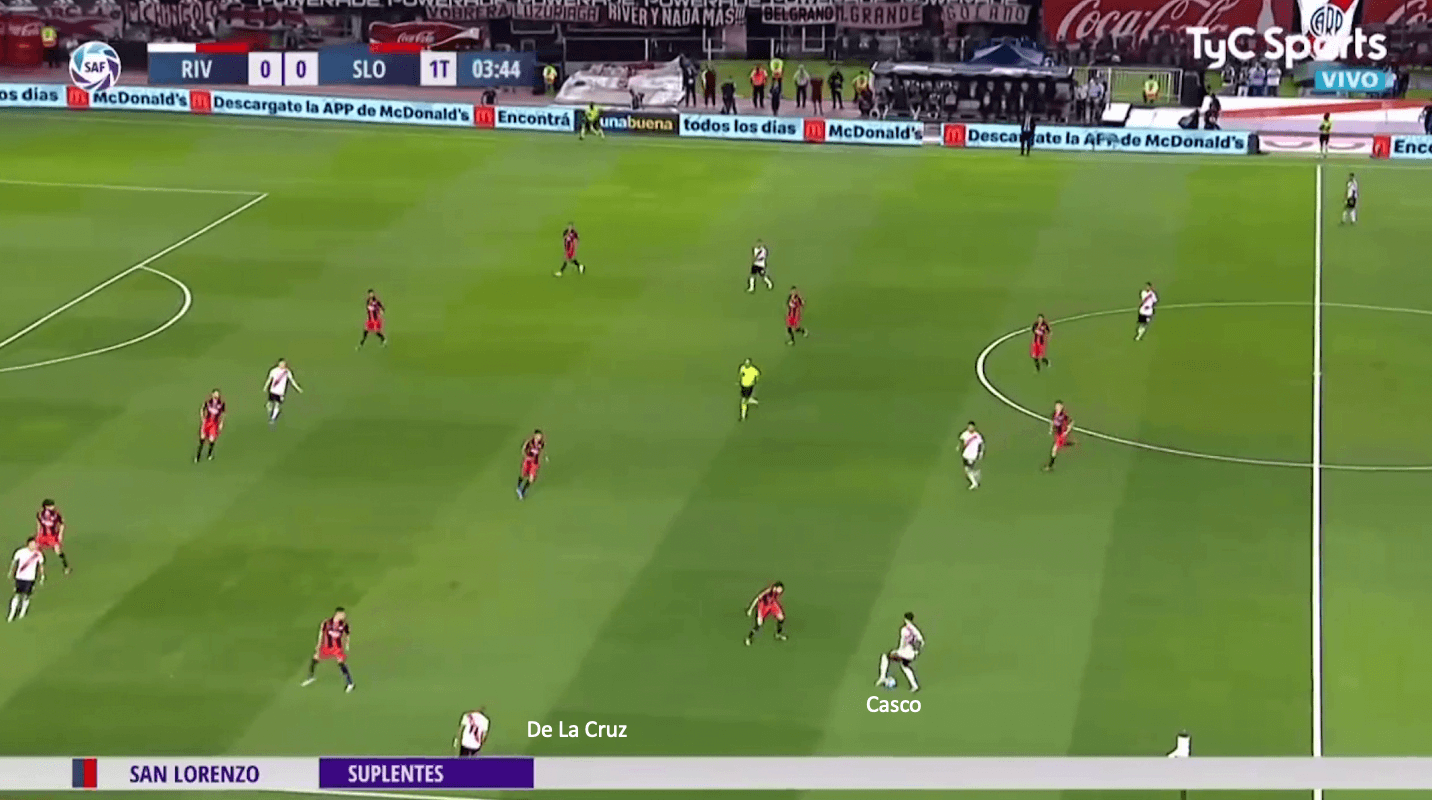
In other instances, the wide midfielders stay central and the full-backs attack through the side areas, which can be seen in the image below, where De La Cruz and Casco switches sides from the previous example and now Casco makes a pass to the forward, who makes a run into the pocket between the full-back and the centre-back of San-Lorenzo.
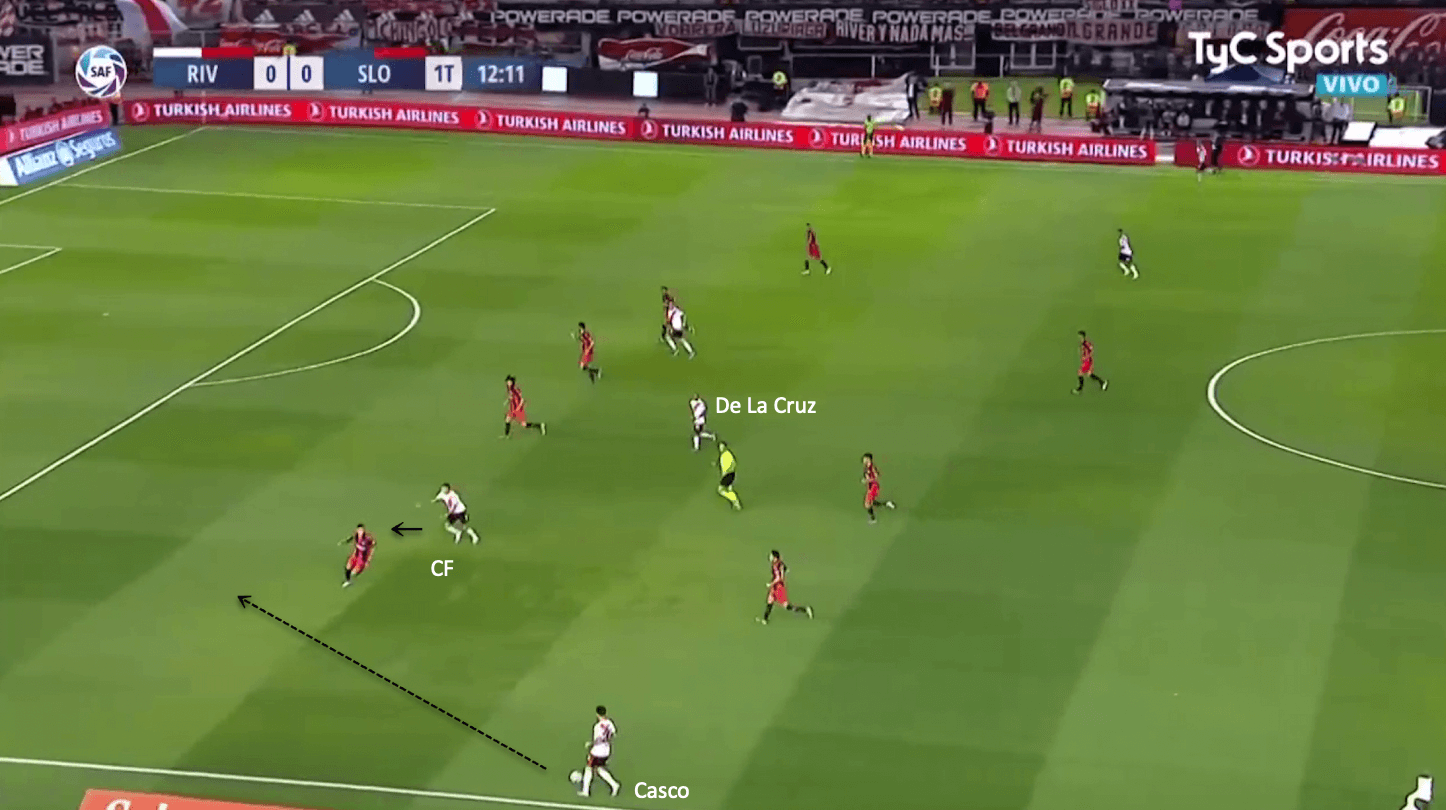
Outside of the mentioned full-back – wide midfielder rotations, which happen most frequently, there are also other movements of wide midfielders, for example to one flank in order to create overloads. I think these two players are the most important in River Plate’s build-up play, as they are given the chance to free roam and create superiorities in different parts of the pitch.
The presence of Exequiel Palacios before his departure to the Bundesliga was vital for River Plate as his versatility and many traits in both attack and defence allowed the team to attack in many different ways. In the initial 4-1-3-2 formation, Palacios would play right above Enzo Pérez, but in the game, he would free roam around the pitch. He could join in as the third centre-back to create superiority, could operate on the flanks and overload the centre. His passing range and directness benefited his team massively, and his defensive contributions, especially his pressing intensity made this system tick. He was the most balanced player in River Plate midfield, and losing him meant that some changes are to be made.
Thus, his transfer to Bayer 04 and the series of unsatisfactory results made Gallardo change his main formation at the beginning of this calendar year and switch to playing with three centre-backs in 5-3-2 formation. Right after the change, the team went on the six-win streak, which sadly wasn’t enough in the end, but it proved that the shift was reasonable.
The general structure in the new 5-3-2 formation, which flowed smoothly into 3-5-2 during the game, is depicted below. Now Enzo Pérez was accompanied with two central midfielders, and the introduction of a one more centre-back saw the full-back partnership of Montiel and Casco play in wide areas more often than previously in 4-1-3-2.
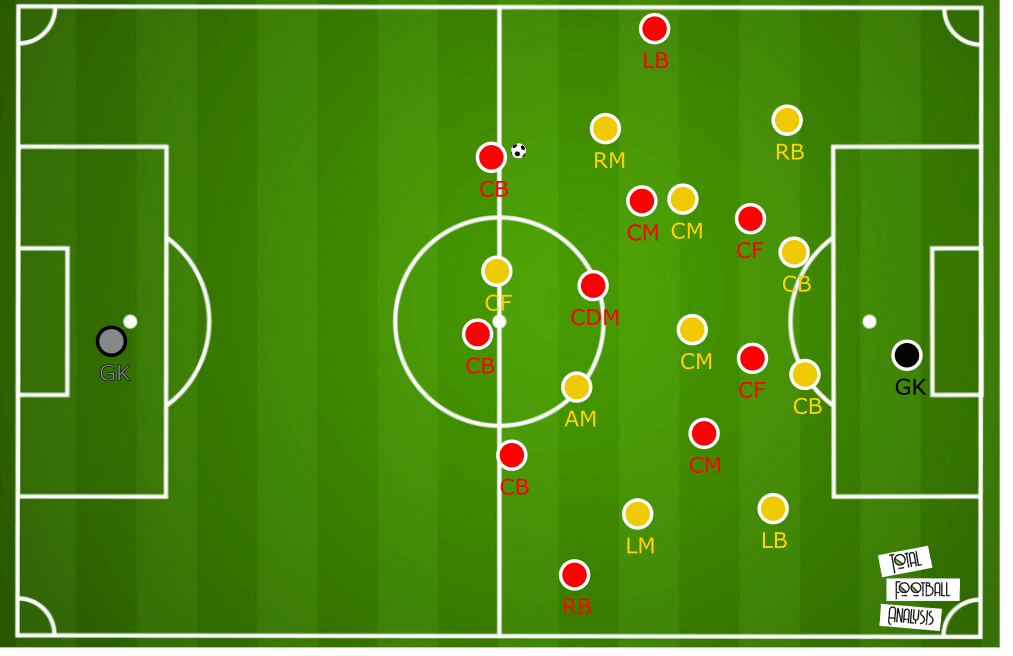
Again, the in-game example is below, with the new man Rojas in the heart of the defence, Fernández and De La Cruz playing centrally while Montiel and Casco are on the wings. Previously, Casco was heavily involved in the build-up from both the centre and when on the flank, and his creativity and excellence on the ball have proven to be great for the River Plate’s attack. In the new formation, his duties partially transferred to the left centre-back Pinola, who has also shown his playmaking abilities, constantly stepping out of the defensive line with the ball and directing the play from the back.
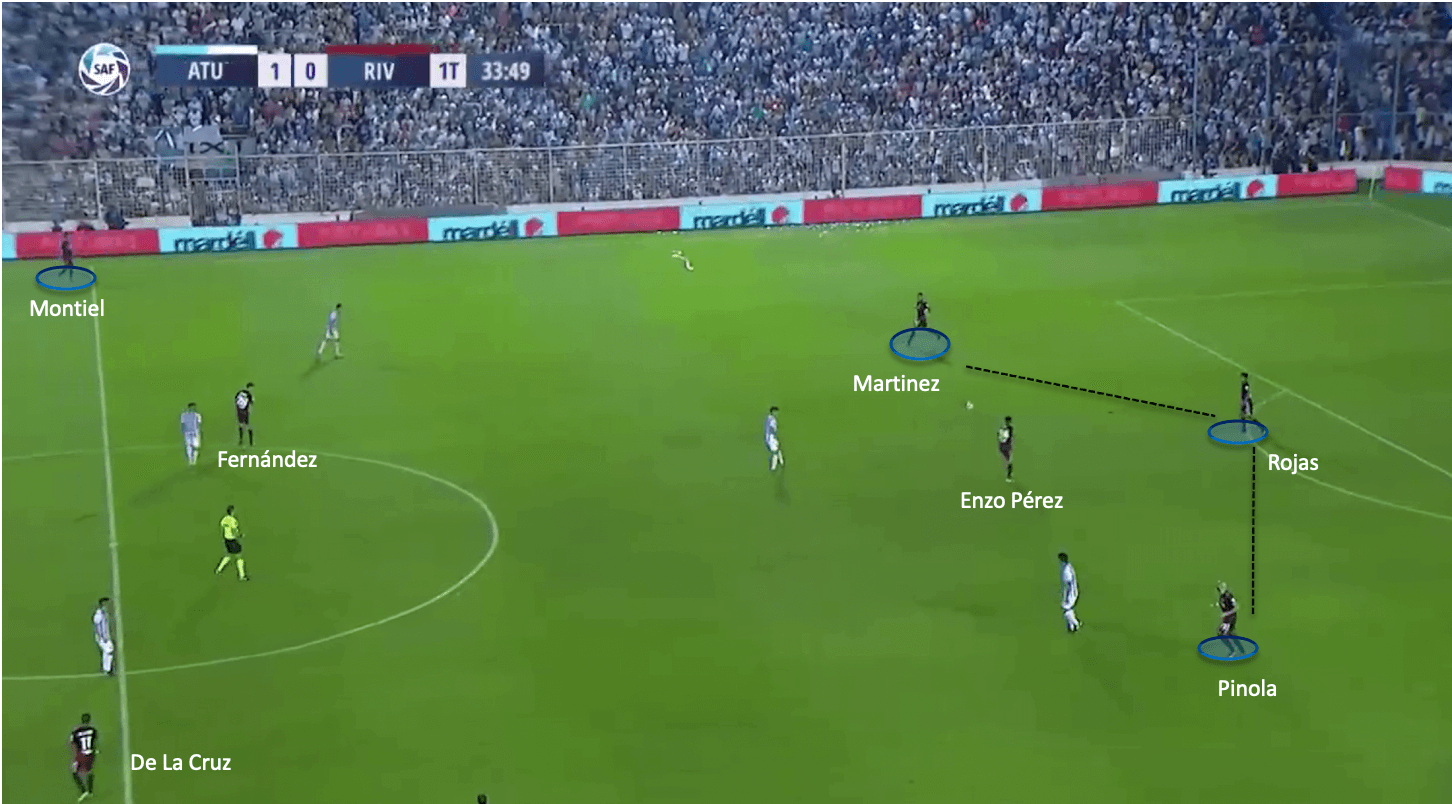
The patterns in the build-up didn’t change much, and River Plate still were looking to progress the ball through wide areas as well as direct play through the centre to the midfielders or forwards
In the next section of the analysis, I will touch more of the attacking movement in the final third, which involves even more rotations and fluidity, and how Gallardo’s tactics help River Plate create a handful of chances every game.
How River Plate create chances
The attacking play of River Plate resolves around the principles of exploiting width and constant positional rotations. Having played in two different systems over the year, Gallardo used the same concepts to open up opposition defences.
The first main principle, using width to progress the ball, allows River Plate to play direct, fast kind of football and get upfield very quickly most of the time. In the image below I illustrated one of the possible situations in-game, which shows the advantages of playing across the whole perimeter of the pitch. Using two and sometimes three of the midfielders to support the forwards directly forces the opposition defensive block to remain narrow. However, with the constant danger in the wide areas from Montiel and Casco, it creates a dilemma for the opposition full-backs. In case they stay narrow, the River Plate full-backs can push up and then it’s delivery into the box. In another case, when they react and decide to mark Casco and Montiel, it leaves the midfielder freely operating in the half-space and making runs in behind the opposition full-back.
The lack of help from attacking wide players(wide midfielders or wingers) I think mainly stems from the activity of River Plate midfielders and in the 5-3-2 formation from the activity from wide centre-backs, Martinez and Pinola.
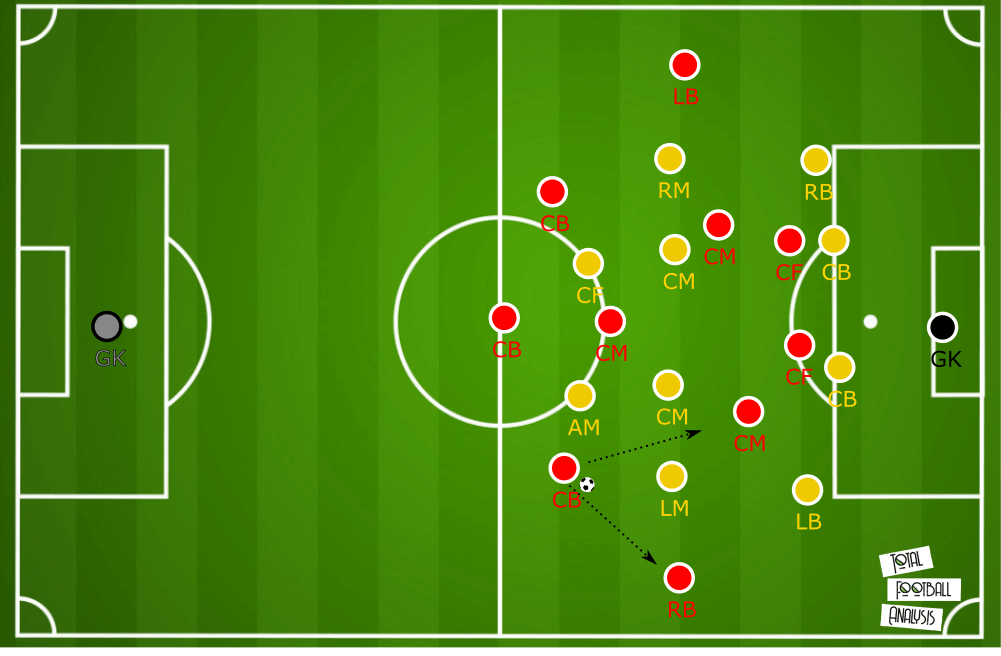
One of the examples is depicted below, where the opposition defence remains really narrow and thus leaving Montiel alone. Also, the ball-near opposition full-back faces this exact dilemma of whom to mark and picking the worst possible variant – staying in half-position, creating a big gap for the midfielder to run through. The midfield players are busy covering Palacios(who is on the ball) and other River Plate players in the middle.
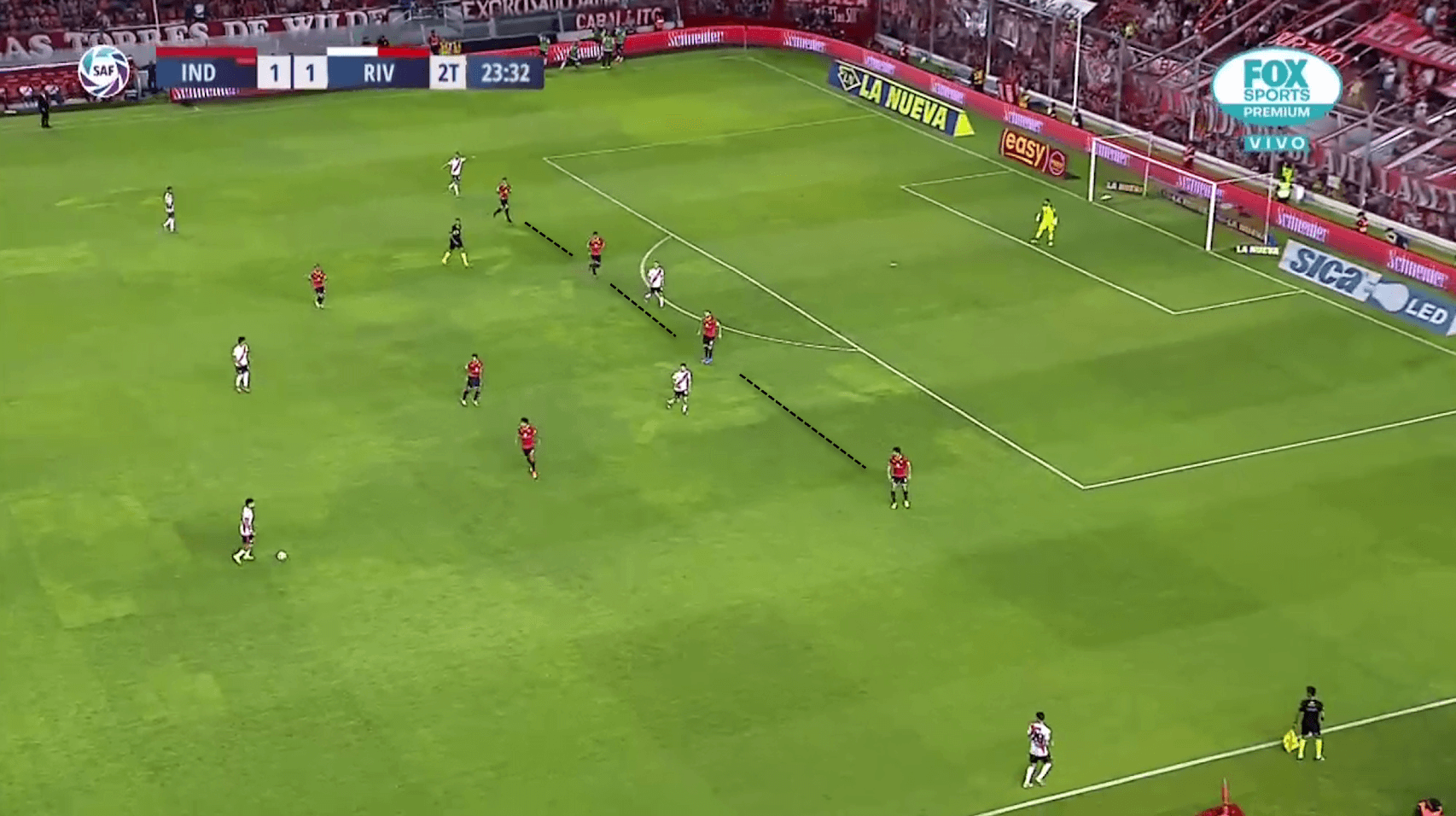
The regular pair of River Plate forwards, Rafael Borré and Matías Suárez do a tremendous job from the attacking standpoint. Apart from obviously being the main goalscorers, they also contribute plenty sometimes by just pinning the defenders and allowing River Plate wide midfielders to operate behind the opposition midfield line. The passing combinations between the wide midfielders and forwards are one of the main ways of how River Plate score their goals. You can see it in the image below, where the two forwards are playing right on the brink of the offside line, and De La Cruz then drops deeper and receives the pass from Palacios. After getting the ball, De La Cruz plays a through ball to Borré for the second goal of the game. Again, because of the forwards regularly making runs in behind, the central defenders are pinned to them, and the full-back is concerned about the Montiel in this example, thus allowing De La Cruz to drop deep and receive.
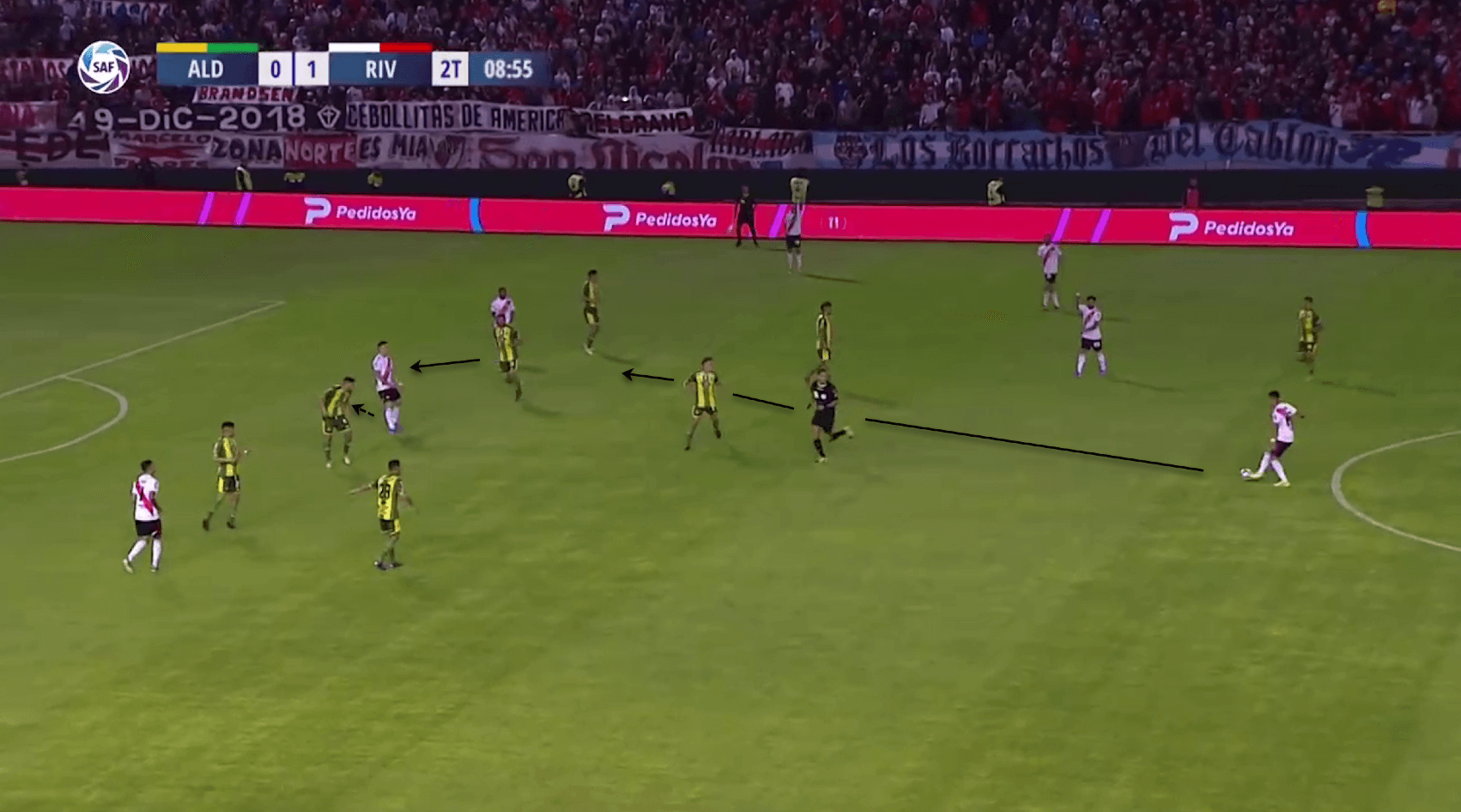
This positioning of attacking players creates a lot of opportunities for playing direct football. In the example below, River Plate players overload the right flank, with Ignacio Fernández and Montiel occupying the left-back and also one of the midfielders. Montiel and Fernández overloading the full-back force the help for him to arrive, and this open a passing lane to one of the forwards, who then goes through and scores.
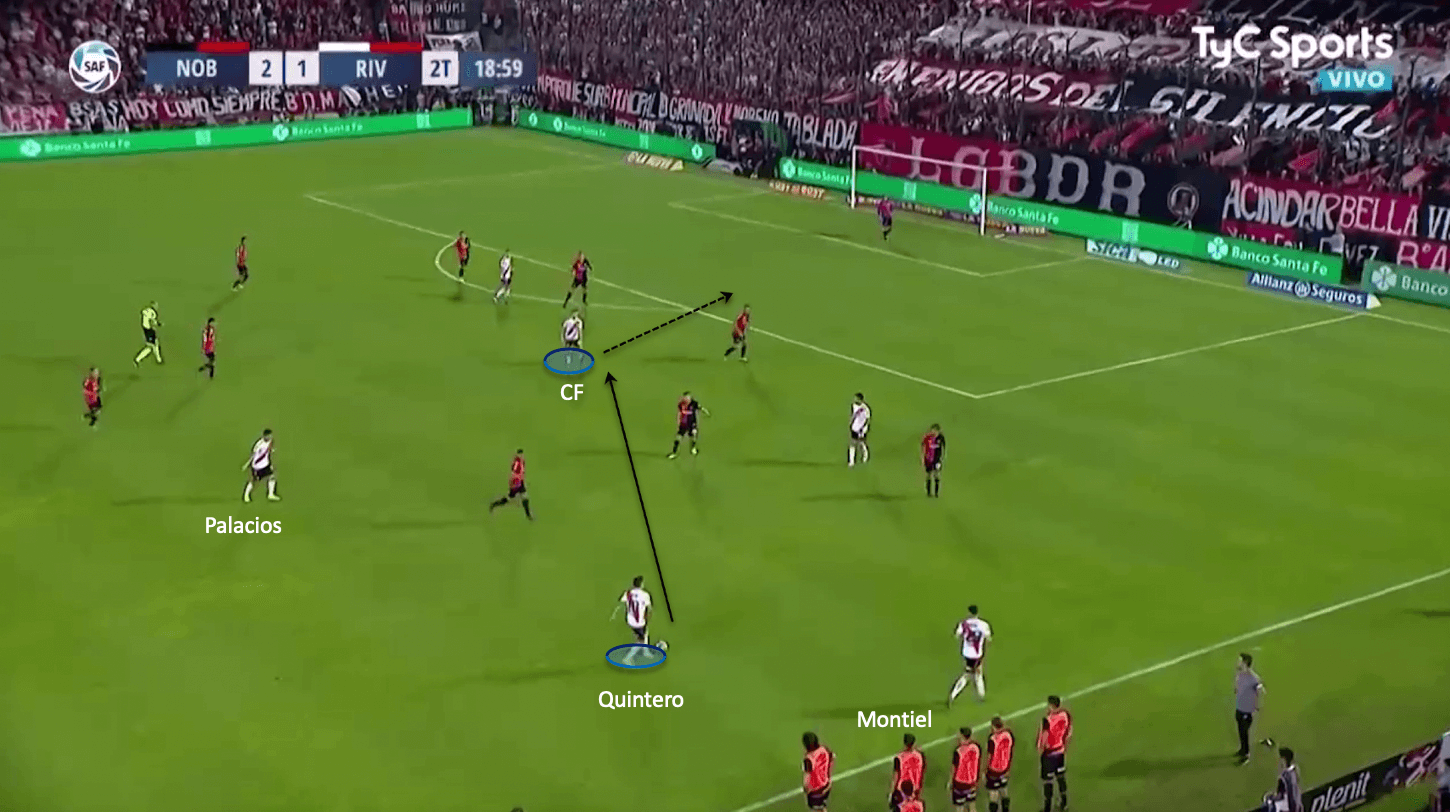
Another important aspect of River Plate attacking style is crosses. In the last five games, four out of 12 total goals scored came from crosses. The two forwards are everpresent in the penalty box when either Casco, Montiel or Fernández are preparing a delivery. Also, oftentimes one of the midfielders also supports the attack with their runs, and it’s especially applicable to Fernández. The forced narrowness of the opposition defence welcomes huge volumes of crosses from both sides of the pitch, and players use this well for creating chances. In the following shot, Casco is about to cross and both forwards and Fernández get into the box to finish, and one of them makes either run to the near post, to the penalty spot or to the far post.
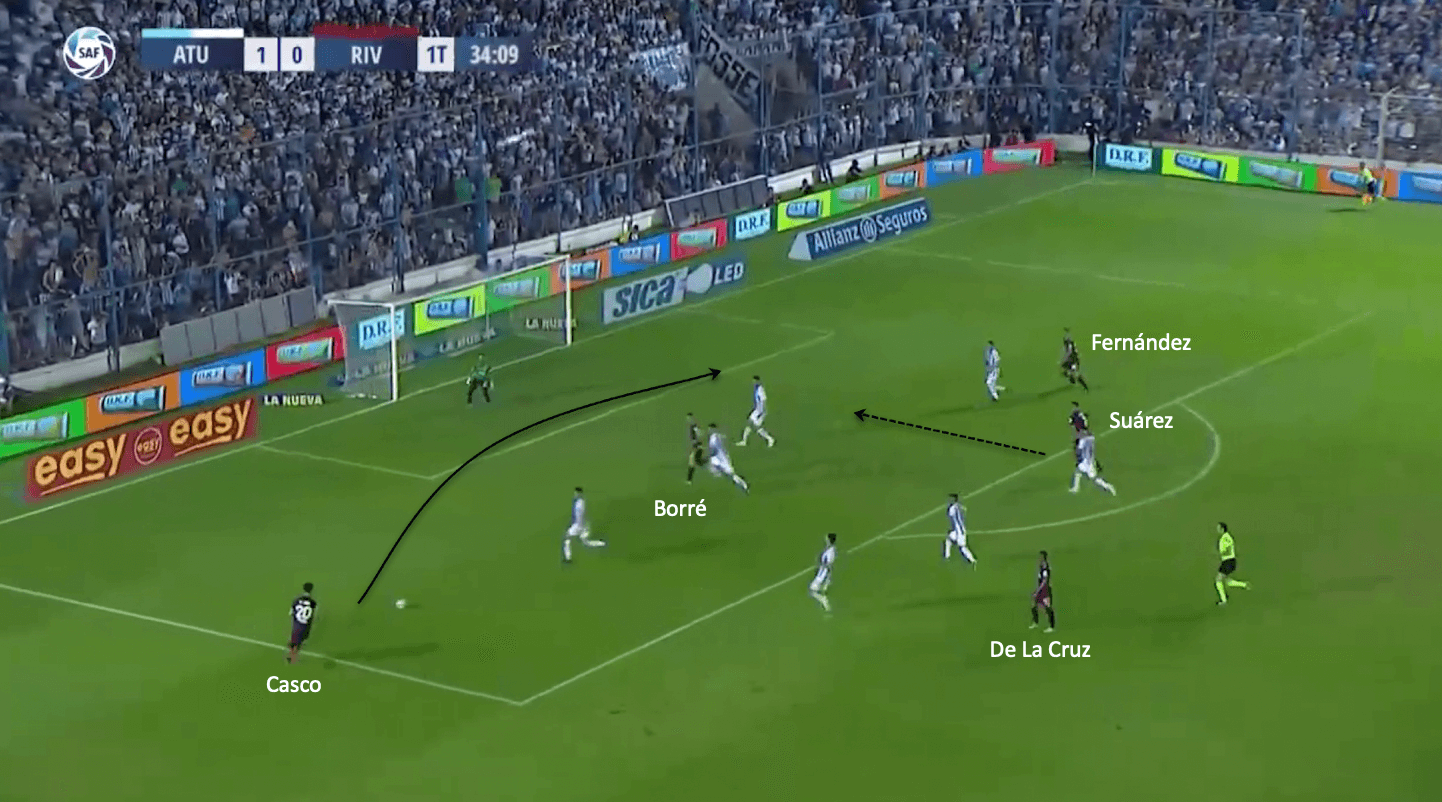
In one of the first examples above I mentioned how one of the forwards was making a run in behind the defence, and this was not a one-time occurrence. As previously mentioned, the two forwards are always ready to make runs behind the defensive line, and they oftentimes have enough support with the other forward and wide midfielder making runs into the box, as well as other side midfielder staying in front of the penalty area in case of a rebound(like in the above picture).
These are the main patterns of attacking play of Marcelo Gallardo’s side, and in the next section, I will delve into some defensive principles of this River Plate team.
Defending
River Plate have been one of the best defences last season, with only 20,61 expected goals against them across the whole season, the second least in the league only behind Boca Juniors. Gallardo’s team is known for their high-intensity pressing, one of the most extreme examples in such a pressing-prone league as Superliga, with the third-highest PPDA of 6,73 passes only slightly behind Gimnasia La Plata and Argentinos Juniors. The principle of rotations that we saw in the previous two sections applies to their defensive structure as well, with some interesting things implemented since the switch to the back-three formation. The general rule during the opposition build-up is to put pressure on the player with the ball and close down the most probable passing options. I illustrated one of the possible in-game examples in the image below, where the opposition left-back is on the ball, and one of the forwards applies pressure on him, while the whole team moves towards the right side of the pitch. The pair of forwards often puts pressure not only on centre-backs but also on the full-backs. Then the right-back Montiel marks opposition player on that wing, and the passing lanes to the centre are open but River Plate midfielders press the receivers in the centre once they get the ball. The most possible outcome of this is the turnover in the centre or the player deciding to play long and giving the ball away.
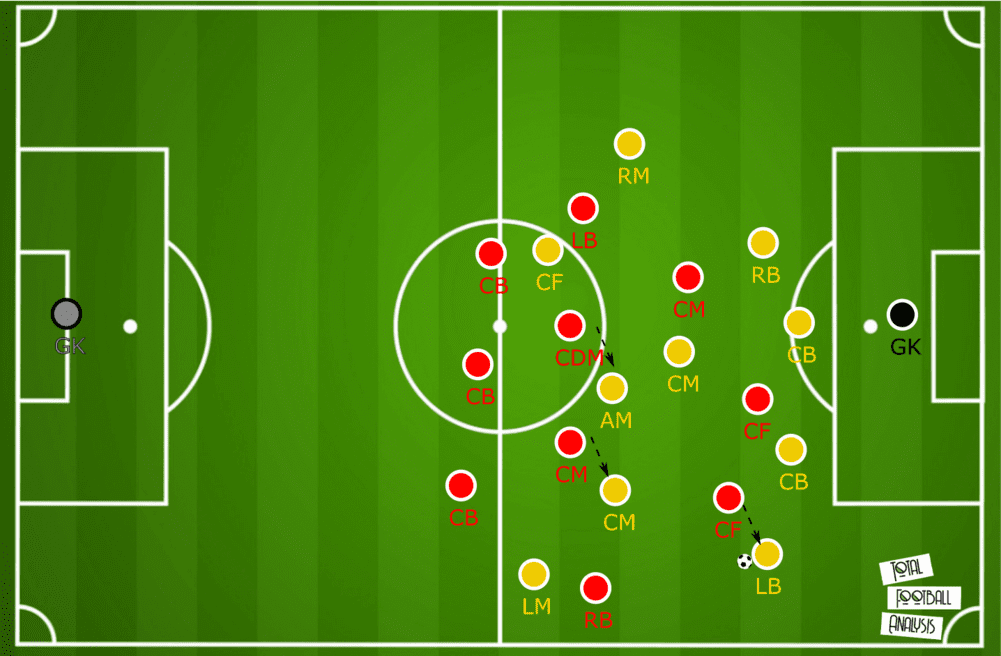
This constant pressure, especially on players receiving the ball, I think is the main reason why opposition centre-backs are not that eager to play through the centre, because the possible turnover might be costly. The easiest option is to go to the flanks, where it is even easier for River Plate to press, as we saw in the above image.
This can also be seen in the picture below, where the right-back gets pressed by the forward, while midfielders cut the most probable passing lanes and ready to press.
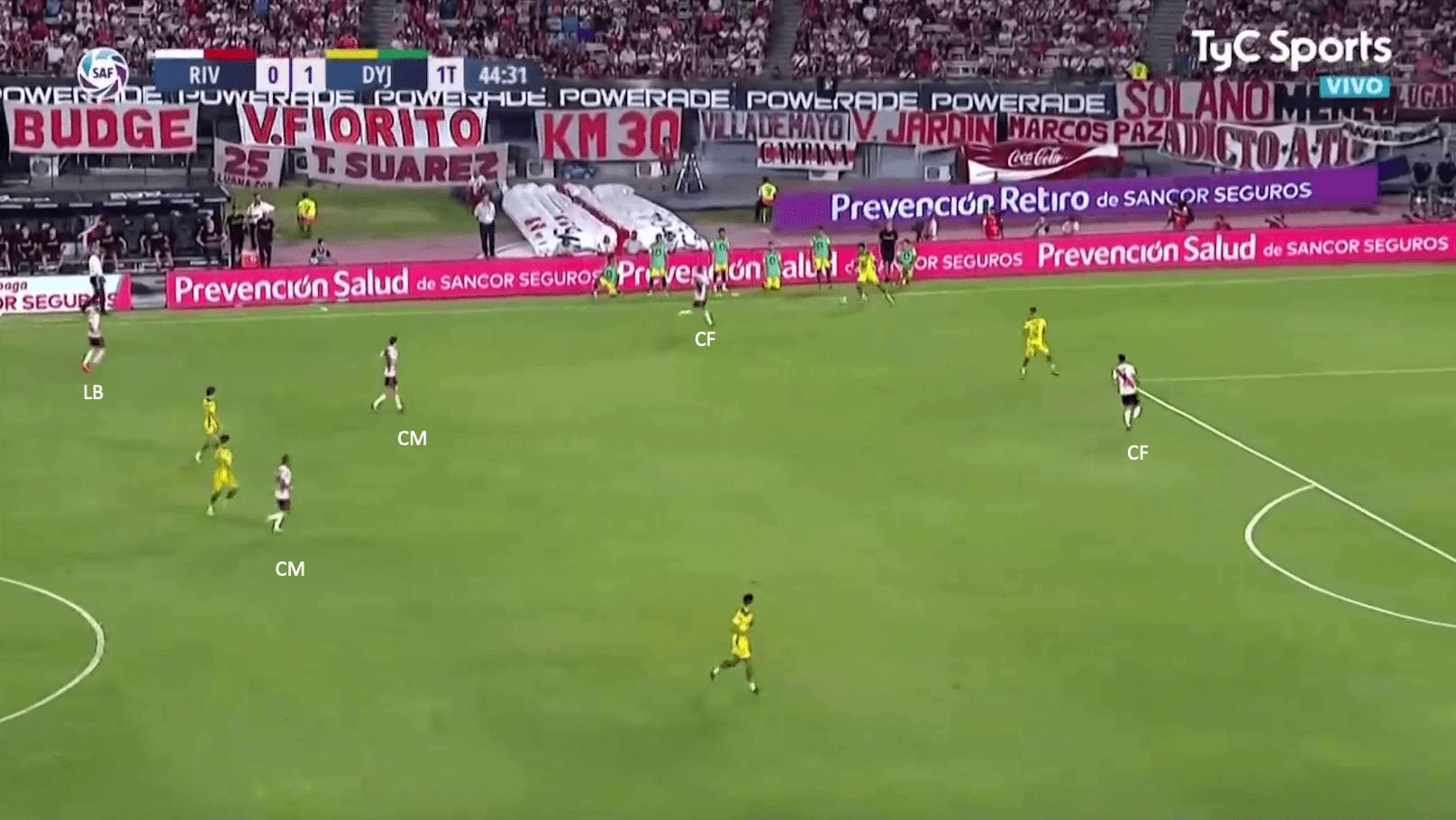
Their high-intensity pressing requires committing a lot of players to win the ball, and River Plate players constantly overload the players on the ball. In the shot below, four River Plate players press one opposition player, with Montiel taking part as well. When in this sequence ball is played to the wing, the absence of Montiel there gets compensated by the centre-back Martinez stepping out of the line and defending wide areas.
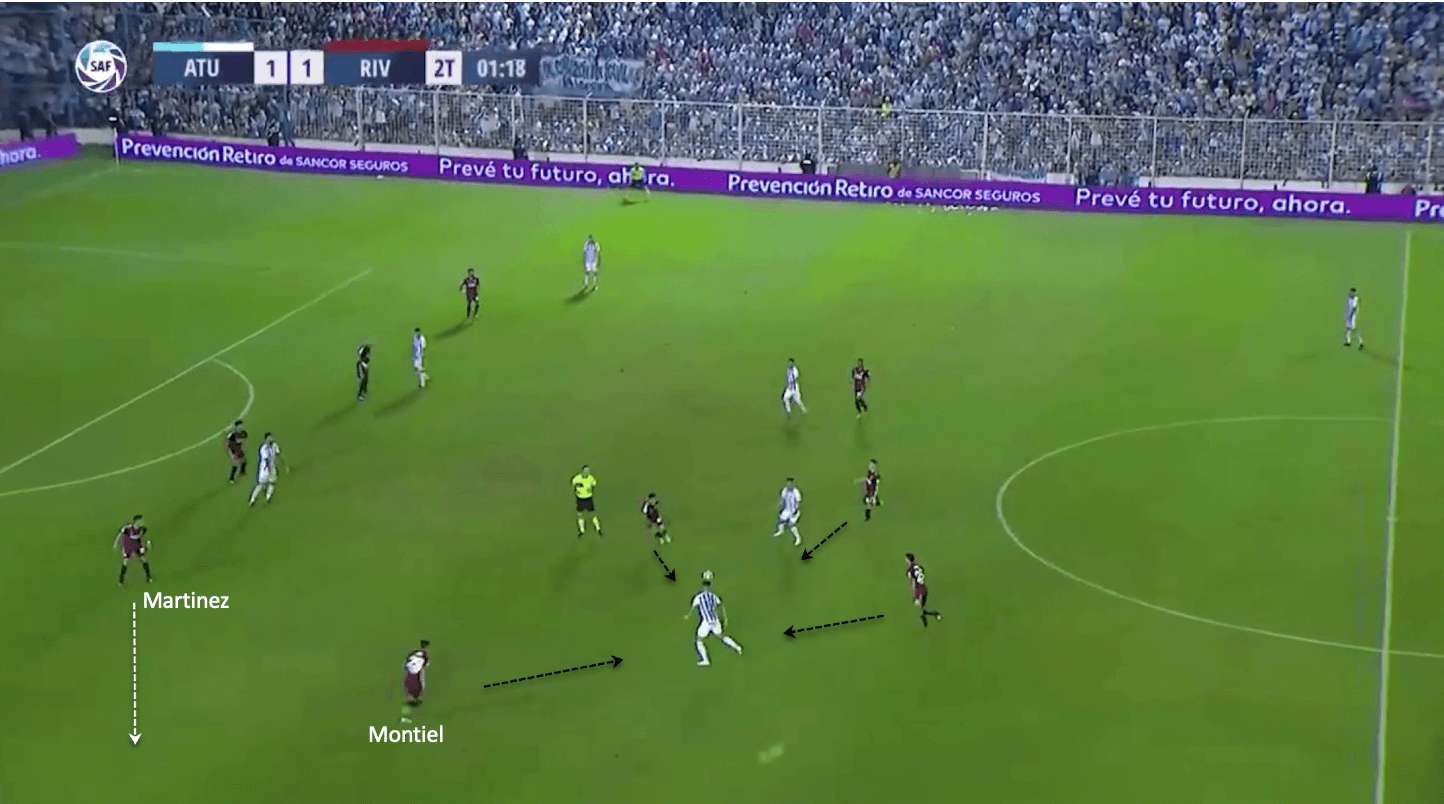
Both full-backs frequently push to the centre and defend like midfielders, while the ball-far centre-back defends the wide-area if the ball is played to the empty flank. This is shown in the picture below, where both Montiel and Casco are defending in the half-spaces.
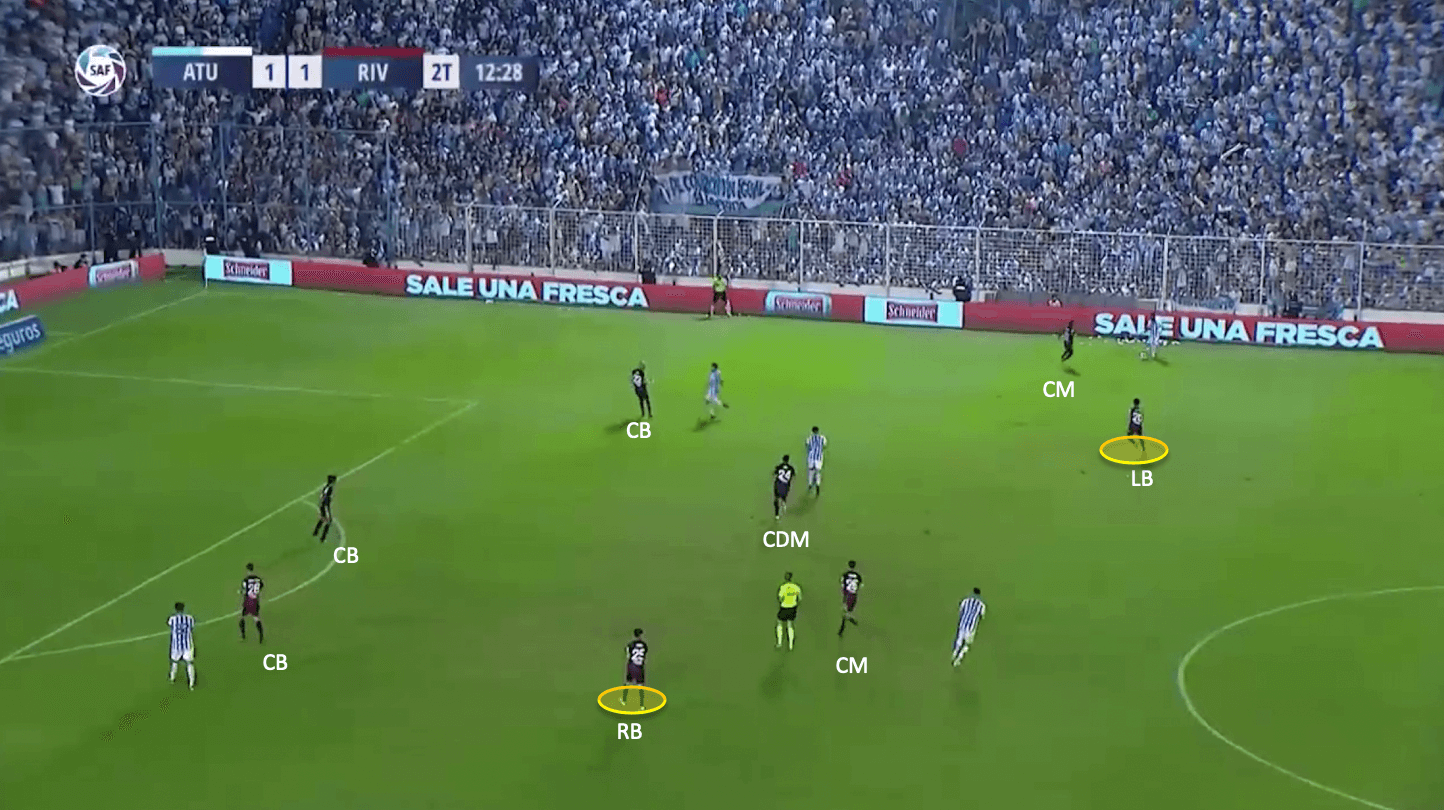
This helps to overload the middle of the park even more, with enough cover being provided by one of the wide centre-backs, making River Plate pressing game even more effective.
In the last example, I want to stress one more time the importance of all forms of pressing in River Plate’s defensive department. When the ball is played wide, six players of Los Millonarios commit to the area to regain the ball. The intensive pressing levels the importance of having great players defensively and allows the team to defend well in the drilled system.
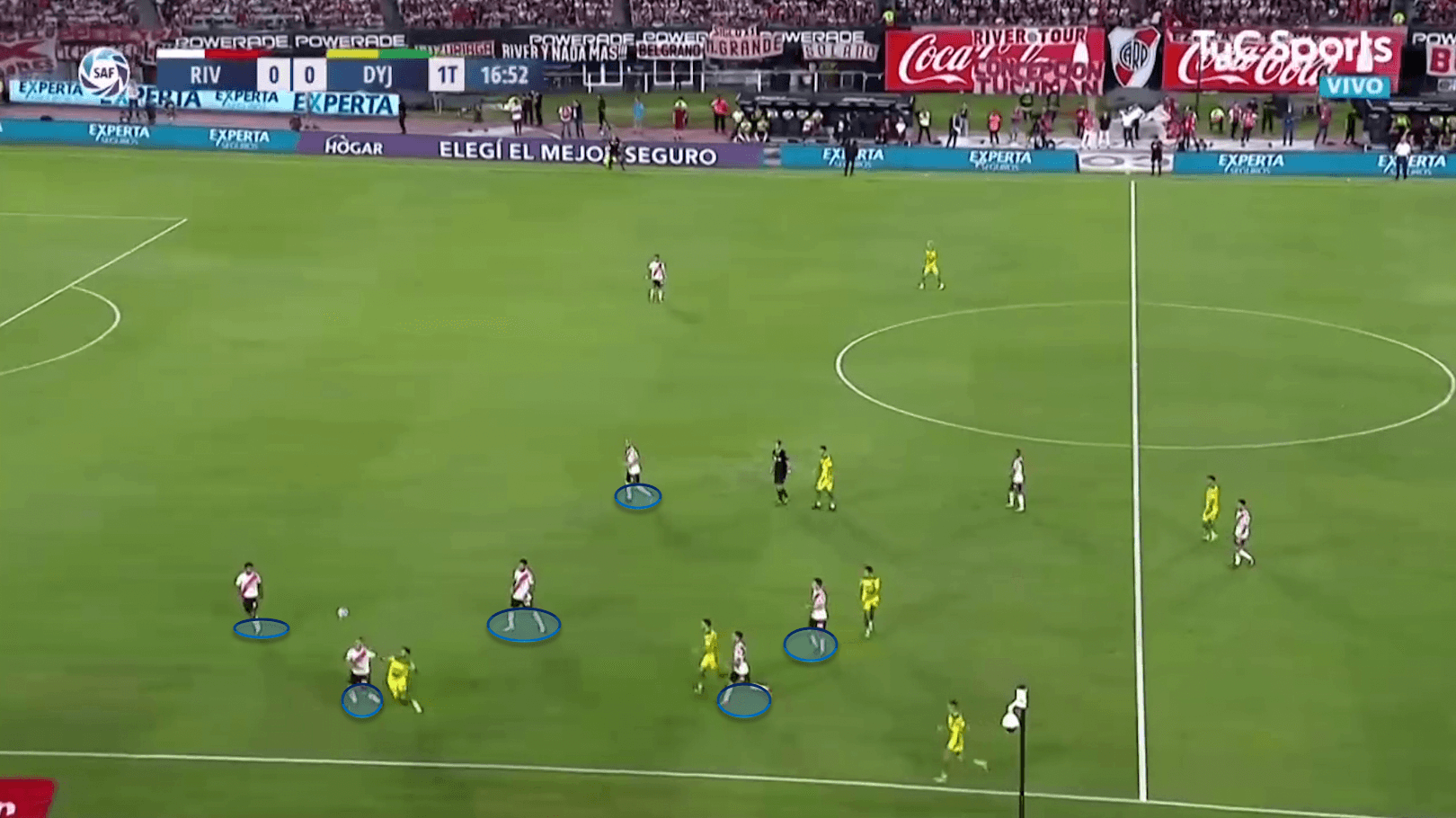
In the next section of this analysis, we will dive in some data visualisations about River Plate and some of its players.
Looking at the data
In the first chart, we will try to understand the correlation between a team’s performance and their actual results. For this purpose, I used expected points and actual points, and it is easy to spot the two runaway leaders in Boca Juniors and River Plate, who at the end of the day acquired 48 and 47 points respectively. However, you can see the gap between these two teams in terms of expected points, with River Plate getting 47,3 expected points and Boca Juniors getting 39,60 expected points, briefly eight points of overperformance.
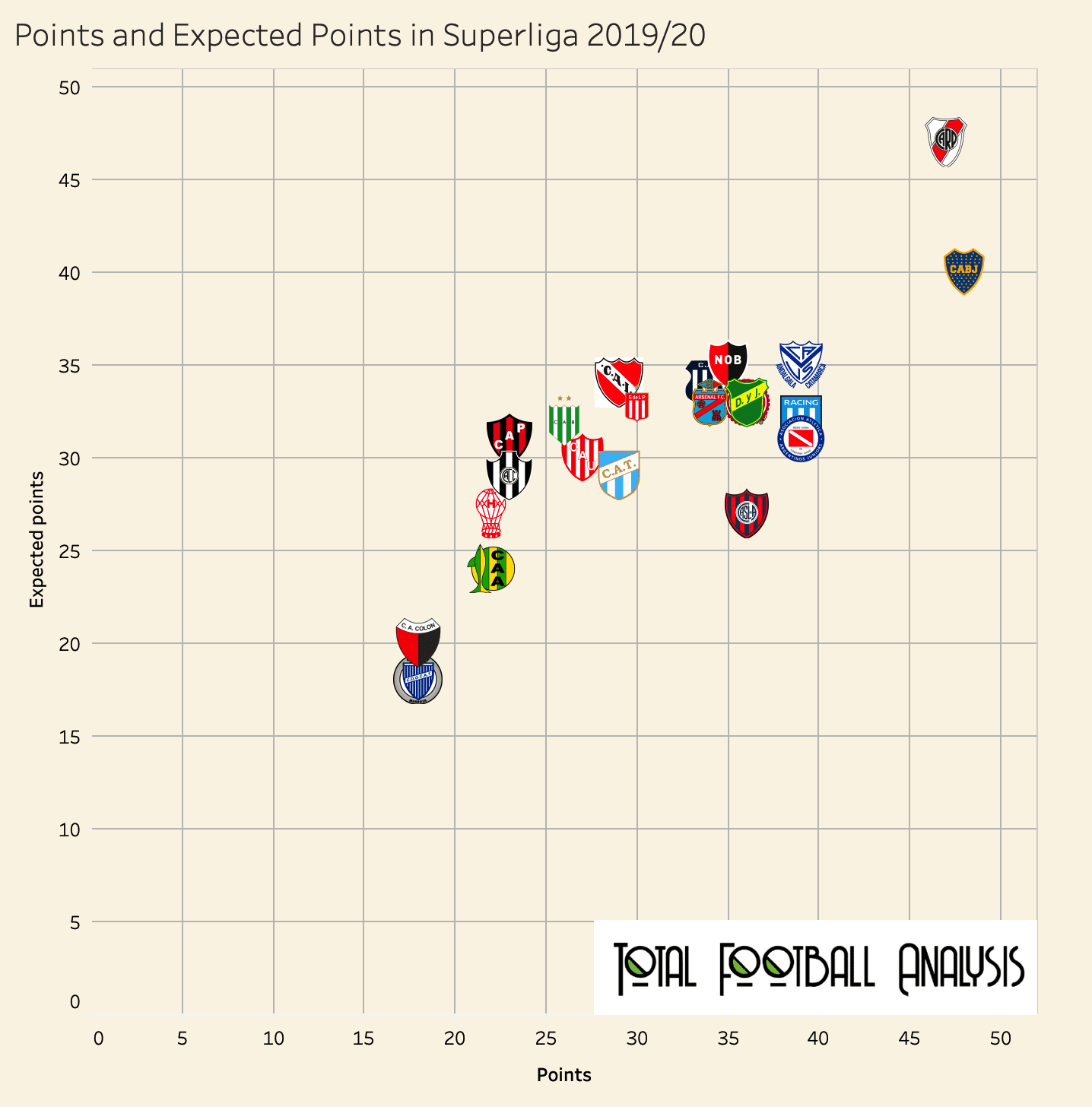
Since the expected points model is derived from such metrics as expected goals for and against, in the chart below you can see both these metrics applied to Superliga teams. Again, River Plate and Boca Juniors are the best in these categories, and there is a gap between these two teams in terms of expected goals. With both teams allowing to create around 20 expected goals against them, River Plate conceded 18 and Boca conceded only eight, which I believe to be the tie-breaker to winning the title.
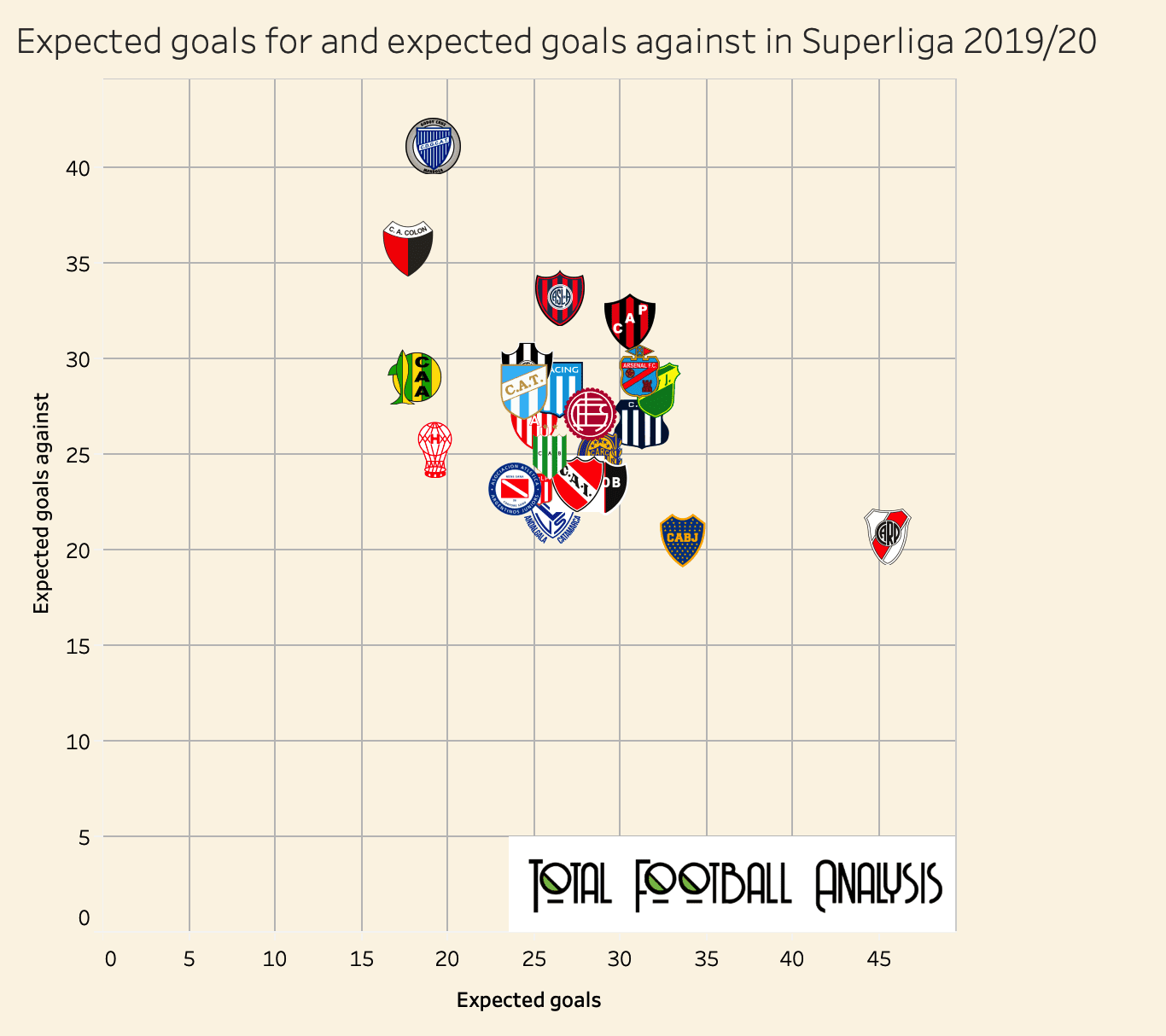
With River Plate being the best-attacking team from the perspective of the expected goals, in this chart, I sorted Superliga teams with the number of touches in the penalty area and shots per 90 minutes. River Plate is by far the best team in these two categories too, recording 15,15 shots per game and 21,36 touches in the box.
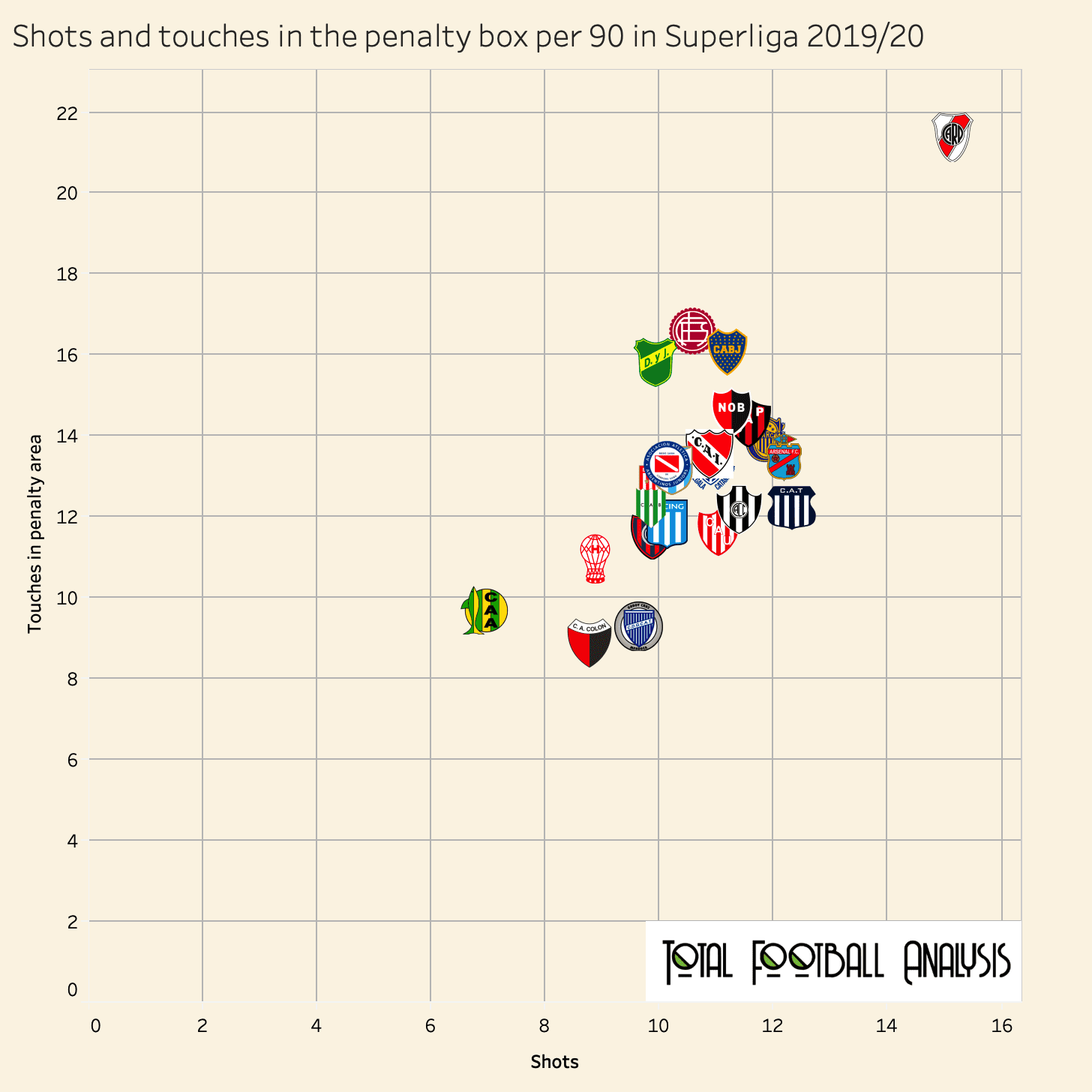
From this, the conclusion is that River Plate was the best team in the league in terms of performance, but Boca’s final run of six wins and their desire made them the deserved champions.
Final remarks
Since Marcelo Gallardo’s appointment in 2014, River Plate have always been in contention for the best team in South America. The Argentinian gave them a recognisable style of play, and most importantly, achieved great success with the club. After such a long and productive spell seeking for a change and the move to Europe is obvious, but regardless if Gallardo leaves the club or not, he will be long appreciated by those crazy fans in Buenos Aires.





Comments